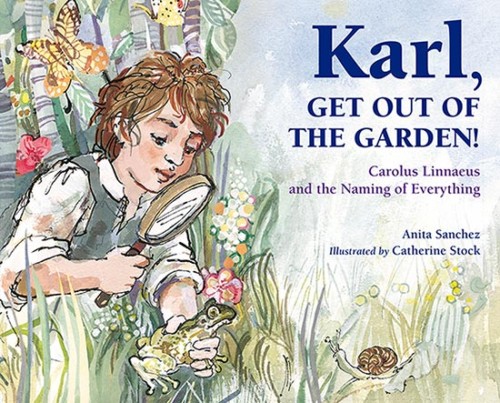by Anita Sanchez, Illustrated by Catherine Stock
Charlesbridge, 2017
Being fond of plants, I expected to like Anita Sanchez’s new book about Carolus (Karl) Linnaeus. What I hadn’t expected was my emotional reaction – I found myself a bit teary-eyed comparing young Linnaeus’s (1707-1778) childhood to my own. Karl was nearly obsessed by the diversity of plants and small animals in his father’s garden; his mother’s admonitions to concentrate indoors on schoolwork went unheeded. Only the threat of apprenticeship to a cobbler convinced Karl that a medical career with its reliance on healing plants was a better alternative.
I had a similar fascination with all things natural. My challenges, however, were exponentially simpler: The many species I was finding had far exceeded the contents of my elementary school children’s guides, and so I had to await impatiently the adult natural history field guides that were just coming on the market after World War II. By marked contrast, Karl had to not only invent, but also gain acceptance for, the simple and orderly classification system now bearing his name.
Establishing order from chaos, Linnaeus persisted – despite initial resistance from the scientific establishment – to refine his system of using a single genus with descriptive species names for each plant or animal. Karl himself named more than 10,000 species in Sweden and nearby Lapland, in addition to those his students eagerly sent him from their extensive explorations in America and around the world. With good humor, he named a beautiful coneflower (Rudbeckia), for a favorite teacher, Olaf Rudbeck, and a genus of weeds (Siegesbeckia), for one of his early detractors.
Karl published Species Plantarum (Species of Plants) in 1753, with fame and wealth soon to follow. Four years later, at age 50, he was knighted by Sweden’s grateful King Adolph Frederick; he then adopted his formal name, Carolus Linnaeus. Twinflower, a dwarf perennial shrub in the honeysuckle family – his childhood favorite – bears his name (Linnaea borealis).
Karl, Get Out of the Garden! is a biography aimed at young children aged seven to eleven. Catherine Stock’s charming, colorful illustrations and a series of children’s sketches of bugs and flowers carry the story and are perfect for children interested in nature. Eight pages of end-matter for parents and teachers enrich and extend the learning.
Why is this story of eighteenth-century Karl’s life relevant to twenty-first-century children? Because with shrinking school-adjacent wild places and fewer educators comfortable teaching outdoors, the need to foster diversity appreciation and stewardship is greater than ever. A quote from Linnaeus in the text reminds us, “If you do not know the names of things, the knowledge of them is lost, too.” Differing local and regional names for plants, and even fanciful horticultural variety names, will always persist and confuse. As it was 200 years ago, the confusion is still resolved by the Linnaean binomial designation of genus and species.
Perhaps most importantly, the book conveys Karl’s sense of wonder at everything from whales to beetles to tiny pink flowers. A reader is invited to observe the circumpolar twinflower in Linnaeus’ coat of arms and then seek it in spring or early summer in cool northern forests and bogs.


